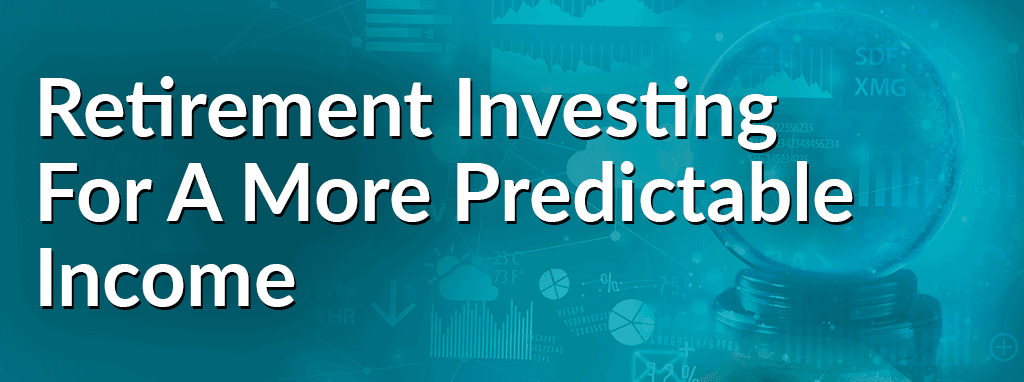What Is The Most Accurate Way To Estimate Retirement Income?
Putting away your money for retirement can sometimes feel like you’re aiming at a moving target. How much should you be putting away right now? How do you know when you have enough?
One of the biggest mistakes many retirees make is underestimating how much they will need to spend in retirement to have a more comfortable lifestyle. They end up overspending because they didn’t plan ahead or didn’t know-how.
It’s a much easier task when you have an idea of how much you will need to maintain your standard of living. To determine how much money you will need to retire, you must estimate your retirement expenses. This is something you can do in a few simple steps.
A good way to begin to estimate retirement expenses is to use your current monthly income as a starting place, and then add and subtract any expenses you expect to change in retirement.
1. What is your monthly take-home pay? This is what gets deposited to you after deductions for taxes, retirement plans, and insurance.
2. What expenses come out of your paycheck that you will have to pay out of pocket once you are retired (for example, health insurance)?
3. What extra expenses do you want to budget for during retirement? This would include things such as travel or hobbies.
4. It is also likely that you will see certain expenses decrease in retirement. For example, transportation and dry cleaning expenses.
What Are Some Of The Safer Investments For Retirement?
As you approach retirement, you start to think more about preserving what you’ve saved rather than achieving aggressive growth. You don’t want to lose the portfolio that you worked so hard to build. Here are some of the safer places to put retirement money:
1. Certificates of Deposit (CDs). Banks offer CDs that are insured by the FDIC, which makes them just as safe as a savings account, but you must leave your funds in the account anywhere from three months to 60 months. Withdrawing them before that could cost you a penalty.
2. U.S. Government Bills, Notes, or Bonds. U.S. government bills, notes, and bonds, also known as Treasuries, are considered the safest investments in the world and are backed by the government.
3. Municipal Bonds. State and local governments sell municipal bonds to build local infrastructure and other projects for the public good. These are both safe and tax-free.
4. Corporate Bonds. If you want higher yields, consider corporate bonds. They generally offer more appealing interest rates but also carry more risk. To help ensure you’re making a wise investment, it’s important to review the rating on the bonds.
5. Real Estate. Real estate may generally be considered a safer investment, depending on local conditions. In addition, real estate may offer steady income, again depending on local market conditions.
6. Preferred Stocks. Preferred stocks are hybrid securities with features of both stocks and bonds. They offer the income potential of bonds, thanks to fixed dividend payments, plus the ownership stake and appreciation potential of common stocks.
Also, for older retirees, investing in your 70s and 80s requires rebalancing your portfolio. Many financial advisors use the bucket approach for aging retirees. This approach helps to ensure funds are available throughout your retirement.
What Percentage Of Your Income Should You Invest For A Retirement Plan?
There’s a lot of conflicting advice about what percentage of your income you should set aside for retirement. Some sources say 10% to 15%, and others say 15% to 20%. It would be nice if planning for retirement were this simple, but it’s not.
It’s certainly better to set aside 10% of your income than nothing at all, but if you want a truly accurate estimate of how much money you need for retirement, you have to do a little math or at least know your way around a retirement calculator.
The first step is estimating how long your retirement will last. This is the least exact part of planning for retirement because you never know how long you’re going to live, and available statistics may have little bearing on you personally. However, they can be useful as a starting point.
The average life expectancy in the U.S. is 78.6 years, but if you’re a healthy person, you should figure higher. One in three 65-year-olds today will live past 90 and one in seven will live past 95, according to the Social Security Administration. Once you’ve chosen your estimated life expectancy, subtract the age at which you plan to retire to determine how many years of retirement savings you need.
Where to put retirement money once retired will vary depending on your circumstances. However, no matter what you decide to do with that money, you must ensure that you have access to it if you need to do so. There’s a certain amount of unpredictability about retirement, particularly regarding healthcare, and you don’t want to be stuck without cash because your money is too hard to reach. Protecting your retirement income is imperative, previously we covered 7 Ways to Help Protect Your Retirement Income. Also, make sure someone else you trust (spouse, adult child, relative or close friend) has the appropriate power of attorney to access funds in the event of an emergency. You’ll have peace of mind knowing that even if you’re unable to make financial decisions, your money is being well cared for.
How Much Money Does It Take To Retire Comfortably?
Academic retirement savings studies use the term replacement rate. This is the percentage of your salary that you’ll receive as income during retirement. To illustrate, if you made $100,000 per year when you were employed and receive $38,000 a year in retirement payments, your replacement rate is 38%. The variables included in a replacement rate include savings, taxes, and spending needs.
The Center of Retirement Research at Boston College looked at how many people have to save to achieve a replacement rate of around 80%. That’s the replacement rate needed to retire at a more comfortable level, say the study’s authors, center director Alicia H. Munnell, and her associates Anthony Webb and Francesca Golub-Sass. The figures varied depending on whether someone was replacing an income that was low (80% replacement rate needed), middle (71%), or high (67%)1.
How Can I Generate Income In Retirement?
The transition from accumulating savings to creating an income stream in retirement presents challenges. Individuals must know the options available and understand that decisions regarding how they choose to invest their savings, along with economic factors such as interest rates and inflation, can affect their monthly income in retirement and how long their assets will last.
Below are the best retirement income stream options:
1. Annuities. Annuities mimic the behavior of a pension by providing a fixed amount of income every month for the life of the retiree. It is the simplest and most direct approach to converting a retirement nest egg into a steady income stream to meet monthly expenses.
2. Laddered Bonds. Unlike an annuity, a laddered bond enables you to convert your savings into cash if needed. Investing in bonds of staggered maturities provides a stable stream of income through regular payments of principal and interest from bonds while maintaining access to your savings.
3. Target Date Funds. Increasingly popular Target Date Funds (TDFs) adjust the mix of stocks, bonds and cash over time from riskier to less risky as you approach your retirement date. A TDF with a systematic withdrawal plan provides an income stream while keeping assets liquid and invested and creates the potential to generate higher returns.
4. Managed Payout Fund. This option invests in both stocks and bonds while reducing the downside potential by providing monthly withdrawals equal to a fixed percentage of the account balance. While this approach can do more to help prevent you from running out of money too soon, there is uncertainty in exactly how much income you will get and what assets will remain, based on market performance.
Sources
Center for Retirement Research at Boston College. “How Much To Save For a Secure Retirement,” November 2011.
Investment Advisory Services offered through Sound Income Strategies, LLC, an SEC Registered Investment Advisory Firm. The Retirement Income Store® , LLC and Sound Income Strategies, LLC are associated entities.






